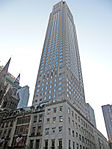10 West 56th Street

10 West 56th Street (originally the Frederick C. and Birdsall Otis Edey Residence) is a commercial building in the Midtown Manhattan neighborhood of New York City. It is along 56th Street's southern sidewalk between Fifth Avenue and Sixth Avenue. The six-story building was designed by Warren and Wetmore in the French Renaissance Revival style. It was constructed in 1901 as a private residence, one of several on 56th Street's "Bankers' Row". The main facade is largely clad with limestone, while the side facades are clad with brick and have limestone quoins. The ground story contains a glass storefront with rusticated molded-concrete piers. The second floor contains an arched Palladian window while the third and fourth stories have tripartite windows. A mansard roof rises above the fourth floor. According to the New York City Department of City Planning, the house has 16,446 square feet (1,527.9 m2) inside. The house was commissioned for stockbroker Frederick C. Edey and his wife Birdsall Otis Edey in 1899. The couple had initially planned to design their house alongside their neighbor H. B. Hollins, at 12 West 56th Street, but a covenant prevented the Edey house from being built for two years. The Edeys occupied the house until 1919, when the Frangold Realty Company bought it and added a sixth story. Over the following years, it was used largely for commercial purposes, though Elizabeth Taylor also lived at the house in the mid-1950s. The New York City Landmarks Preservation Commission designated the house as an official landmark in 2007. The house has been owned by billionaire Carlos Slim since 2011.
Excerpt from the Wikipedia article 10 West 56th Street (License: CC BY-SA 3.0, Authors, Images).10 West 56th Street
West 56th Street, New York Manhattan
Geographical coordinates (GPS) Address Nearby Places Show on map
Geographical coordinates (GPS)
| Latitude | Longitude |
|---|---|
| N 40.7625 ° | E -73.9754 ° |
Address
West 56th Street 10
10019 New York, Manhattan
New York, United States
Open on Google Maps






